Fishing kayaks are the ultimate fishing machines. They combine the maneuverability of a kayak with the fishing capacity of a boat. They offer a wide range of fishing features, including fishing rod holders, rigging channels, and even fish finders. They’re also great for fishing in shallow water and are a ton of fun to paddle.
Today, we are going to go over how to set up a fishing kayak so you can get out on the water as quickly as possible. There are a lot of different fishing kayaks on the market, but they all have the same basic setup.
Setting up a fishing kayak with your gear can be endless. You can customize your fishing kayak with whatever you want on it. Some setup requires lots of investment while other requires basic or low investments. Investment in a fishing kayak setup depends on how passionate you are, your financial capacity, and overall your willingness.
So first of all we will look at some of the gears that are used for fishing. Then we will summarize these into basic and advanced setup.
Table of Contents
Fishing Kayak Setup Requires A Proper Type Kayak
In general, sit-on-top kayaks are better for fishing than sit-in kayaks. They’re great for when you don’t want to sit on a chair for long periods of time, like when you’re fishing, or when you want to really enjoy the feel of the water. They’re also great when you want to get up and move around, but still want to be able to see where you’re going.
Sit-in kayaks are better for high performance in high waves and touring long distances. If you want to do fishing using your existing sit-in kayak, it may be possible. But you will get into trouble in attaching fishing gears and will not feel comfortable in fishing due to its tight sit-in position.
So, the final answer to the selection of a fishing kayak is to select a sit-on-top kayak. If you argue about this learn more about sit on top vs sit-in kayaks and which one is for what!
PFD
Why do I need a personal floatation device (PFD)? A PFD is a personal flotation device used to stay afloat in water. It is used by kayakers and sailors to ensure that they remain afloat during periods of heavy rain or wind or if they fall into the water. Many kayakers do not wear a PFD having overconfidence. Such overconfidence may lead anyone to a hazardous situation. So, don’t compromise on a PFD.
Paddles
Paddles are one of the important elements in fishing kayak setup. It is used from the beginning of the invention of the kayak. Different types of kayak paddles are available today. So you need to know which type of paddle is good for you in respect of length, material, and comfort.
Paddles for fishing kayaks are generally longer than those for recreational kayaks. The length of the paddle will depend on the type of water you will be fishing in. In calm water, a shorter paddle can be used to maneuver the kayak. On the other hand, a longer paddle will be needed for water with higher currents.
Things to consider during the selection of paddles for a fishing kayak.
- If your kayak has an adjustable seating system you should choose a paddle that has an adjustable length option.
- For a high seating position, you will need a long paddle than in a low seating position.
- The angle of the blade is another vital issue. There are two types of angles that are provided to all the blades. One is the high-angled blade another is the low-angle blade. High angle blade is needed to paddle your kayak faster or if you have lots of gear or your kayak is heavier. Whereas a low-angle paddle is required for slow and relaxed kayaking to spend several hours on the water.
Fishing Rod
Fishing is a great hobby and a fun way to spend time outdoors. Using a fishing rod to catch fish is a classic pastime that has been passed down through the generations.
Today, there are a variety of fishing rods available for purchase, ranging in price and style. Some are better suited for fishing than others. Having the right fishing rod can make all the difference when it comes to getting a great catch. The characteristics of a fishing rod include length, action, and tippet material. The length refers to the length of the fishing rod.
If you want to cast in a long distance you will need a long fishing rod. On the other side if you want shorter distance casting then choose a shorter rod. For accurate casting, shorter rods are preferable to long rods. Action refers to the degree to which the fishing line is allowed to recover after a fish bites.
Fishing Crate
Fishing crates have become an important part of kayak fishing. They help kayak anglers organize their gear and keep their fishing rods and reels protected. They also help kayak anglers keep their gear neat and organized in their kayaks. Fishing crates help kayak anglers keep their gear organized and easy to access, allowing them to spend less time getting their gear together and more time fishing.
Fishing Net
The fishing net is also an important accessory for any kayak fisherman. The fishing net allows you to fish off the side of your kayak without being limited to the space inside the kayak. This means you can fish off the side of your kayak without having to worry about your space or your line getting tangled up in the kayak.
Dry Bags
A dry bag is a great way to store some of your essential items like your phone, cameras, your snacks, etc. They can help you to protect them from water and bad weather. A variety of dry bags is available in the market. Some of them are made especially for kayaking.
Fish Measuring Tools
Fishing regulations are the laws and rules that govern when, where, and how you can fish in a particular area. These include size limitations, area limitations, commercial or recreational fishing limitations, etc. The goal of fishing regulations is to manage the ecosystem of water and to protect fish populations so that they can thrive and continue to provide great fishing for years to come.
Fishing regulations vary widely across the United States. In some states, such as Montana, there are no fishing regulations and anglers can fish on almost any body of water, at any time, for any species of fish.
So to comply with the regulation you may need some measuring tools like a ruler, bag size, etc. So, before going fishing, check out regulations in your area.
Fish Finders
Fish finders are special types of sonar that help anglers find schools of fish. They’re designed to emit a beam of sound that’s reflected off of fish, helping you find where the fish are so you can cast your line. Fish finders come in a variety of different forms, such as transducers, computers, and mobile apps. Some of them are designed to provide you navigation path to your favorite fishing spots and lots more interesting features.
Anchor System
The anchor system is the mechanism that allows you to keep your kayak in position in the water. It is generally made up of a chain, an anchor, and a few other pieces to keep you in place. The anchor is the device that is used to hold your kayak in one place in the water. There are many different anchor types that can be used in kayaking, including Danforth-style anchors, fluke anchors, grapnel anchors, and anchors that are built into the kayak.
Trolling Motor
Trolling motor is an engine fitted at the rear of your fishing kayak that rotates the propeller to create thrust while the boat is underway. The use of trolling motors enables an angler to fish from a greater distance than is possible with human power alone. The reason trolling motor is necessary for your fishing kayak is to make your fishing more effective. You can use it to catch fish that are otherwise out of your reach.
Kayak Battery
Did you ever consider using a kayak battery in your next kayaking adventure? The kayak battery, also known as a trolling motor battery, is a small, portable power source designed to provide power to small accessories, such as LED lights, GPS trackers, trolling motors, fish finders, and even radio communication systems. The best part is that you can find a battery that will fit your needs and budget.
Basic Fishing Kayak Setup
We have learned about the gears that are used for kayak fishing. Basic fishing kayak setup will be done based on level of expertise (beginner or pro), cost, and enthusiasts of anglers. At the very beginning of kayak fishing, you will not be used to kayaking or angling that much. We suggest you to learn a few basics of kayaking as well as manual fishing. This will help to become a perfect pro angler.
So let’s see what you should add to your kayak for a basic fishing kayak setup. Here is the list of gears:
- A sit on top kayak
- A Long paddle with a high angle blade
- Fishing rods
- A good PFD
- Fishing net
These are the minimum list for a basic fishing kayak setup. For storing fish you can use your tank well that is provided in your kayak. If you don’t like to put there then add a fishing crate to that list. Now let’s move on to advance fishing kayak setup.
Advance Fishing Kayak Setup
After having some basics on fishing done by basic setup or any previous experience, you can add several other gears and accessories to your fishing kayak and become a pro angler. Now, I think it is worth investing to customize your kayak to get more fun on the water. So, let’s dive into the list of advanced fishing kayak setup. Here it goes!
- A sit on top kayak
- A Long paddle with a high angle blade
- Fishing rods
- A good PFD
- Fishing net.
- Fish measuring tools.
- Trolling motor.
- Fish finder.
- Kayak battery
- Anchor system etc.
At the end of this article, we can say that the fishing kayak setup determines how passionate you are about kayak fishing. We also understood that customizing a fishing kayak with all high-tech equipment requires a good amount of investment. Luckily these high-tech accessories will provide you an ultimate pleasure during fishing from the kayak.
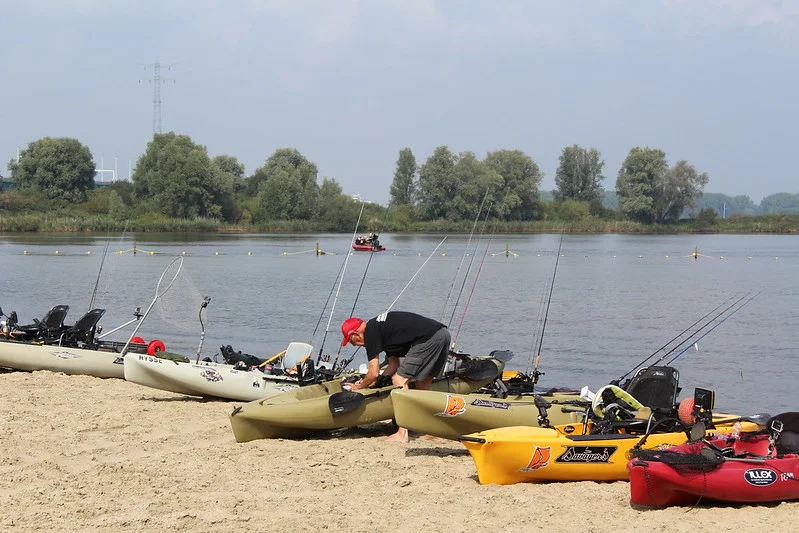
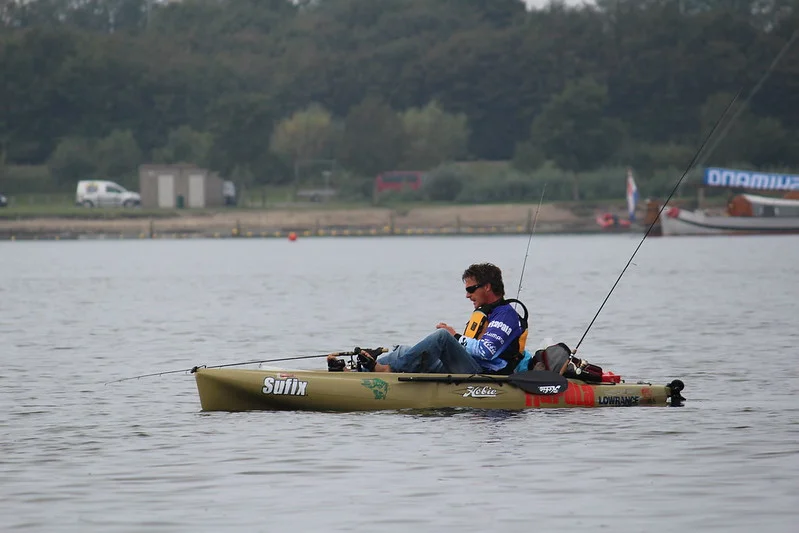
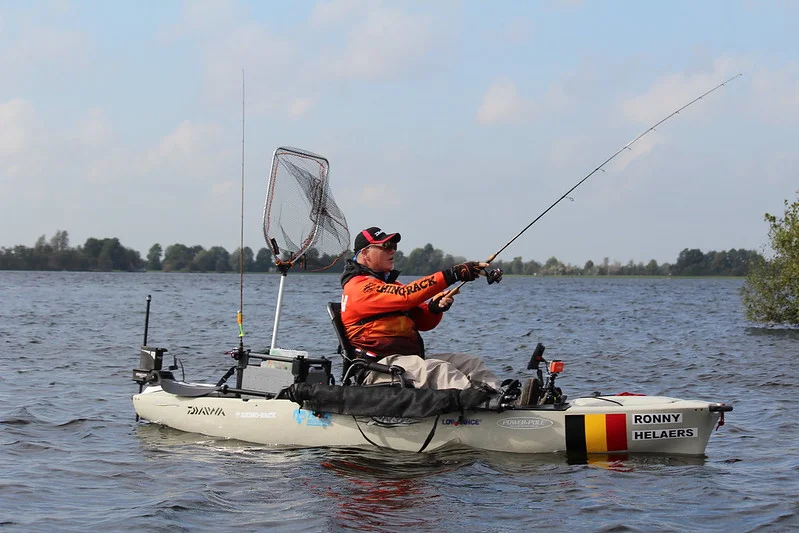
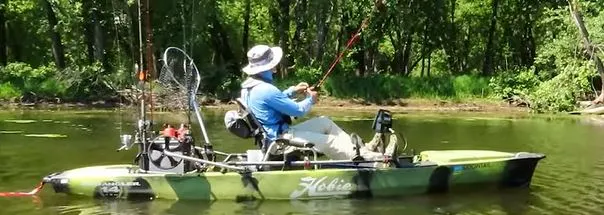
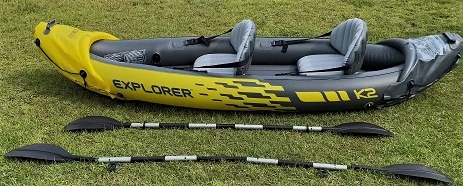
Pingback: Do fishing kayaks have live wells? - Safekayaking
Pingback: 7 Best Kayak Carts for a Comfortable transportation - Safekayaking